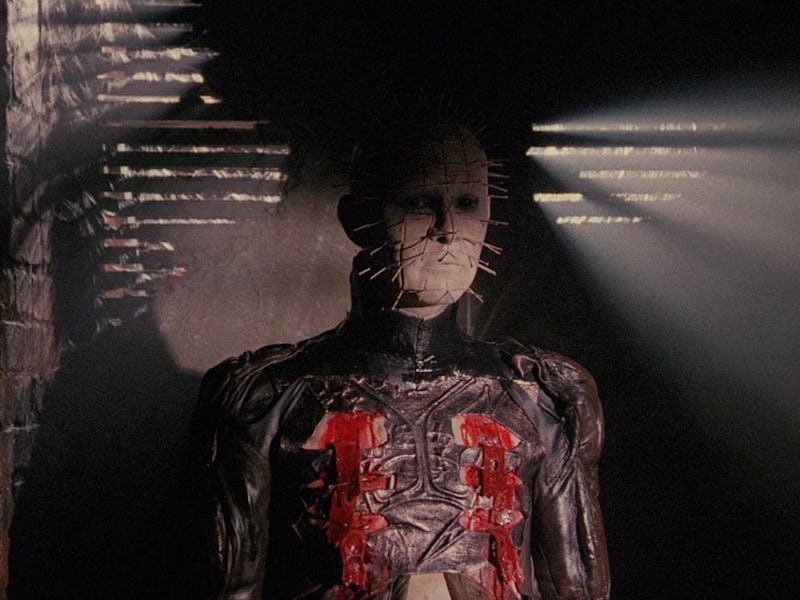You need to watch the sexiest sci-fi thriller of all time on Amazon Prime ASAP
When you ask Hell for help in the bedroom, you better mean it.

Horror cinema has never been sexier. It Follows rode the genre’s mid-2010s wave with a big, self-evident metaphor about STDs and consent. Carnal confusion is key in the cinema of Julia Ducournau. And, in 2023, Ti West will score the unprecedented hat trick of banging out a full boobs ‘n blood slasher trilogy in just a year and change with Maxxxine, the capper to 2022’s X and Pearl.
But 35 years ago, this wasn’t the case. When Clive Barker made his directorial debut on September 18, 1987 by adapting his own novella, The Hellbound Heart, into Hellraiser, censors had a conniption. Incensed by the picture’s spicy blend of lasciviousness and violence — a brew best described as “an acquired taste” — they slapped the film with an X-rating.
Cuts were made to the pantomimed sex. (Spanking, of all things.) A climactic kill scene hinging on explosive dismemberment was reduced to a single shot. So it goes.
But even after Barker made the MPAA’s demanded edits and adjustments, Hellraiser was still too shocking for polite society. That was the point, and today the point hasn’t changed. Hellraiser is a movie intended to descend the deep dungeons of human desire and poke at our darkest appetites. It’s a sexual horror movie, and there’s nothing playful or coy or affected about its presentation of sexuality.
Most horror movies expose naked flesh for titillation’s sake. Hellraiser does so to raise uncomfortable questions about sexual gratification: What turns us on? What’s the dividing line between our personas in and out of the bedroom? How far are any of us willing to go in the pursuit of pleasure? The film provokes uneasily reconciled reactions in viewers through a cinema of extremes — extreme lust, extreme violence, and extreme fright. Hellraiser is utterly terrifying. It’s also self-revelatory for each audience member, revealing their known turn-ons and their repressed fixations.
The Lament Configuration is an ornate puzzle box that calls the Cenobites.
Hellraiser concerns the Cotton family:
- Larry (Andrew Robinson)
- His daughter, Kirsty (Ashley Laurence)
- And his second wife, Julia (Claire Higgins), who is also Kirsty’s stepmom
Larry’s a cuckold and he doesn’t know it. On their wedding day, Julia screwed his brother, Frank (Sean Chapman), a self-aggrandizing hedonist prick. Frank has seen it all, done it all, and gotten so bored with it all that he seeks out an extra-dimensional sexual aid, and boy does he find it.
Hellraiser opens as Frank acquires the Lament Configuration, an ornate puzzle box that, when solved, calls into the world a fistful of BDSM-outfitted demons known as the Cenobites. They hear his plea. They respond in kind with hooks, chains, and tension force strong enough to eviscerate him. When you ask Hell for help in the bedroom, you better mean it.
Meet the Cenobites.
Some time later, the Cottons move into Frank’s poorly kept, presumably empty home. Larry cuts his hand on furniture in the process and Blood drips into the attic floor. Up rises Frank, a sentient puddle of goo. It’s bad news for Larry and Kirsty that Julia finds him first, but ecstatic news for Frank. He enlists Julia to bring him men who think they’re about to get lucky with Julia. Instead, Frank kills them and uses their flesh to replenish his emaciated body.
Kink abounds in the setup. The aforementioned cuckoldry, for one, plus fluctuating lines of voyeurism and troilism. Frank likes to watch. He also likes to be in control. The dominance element at play in his dynamic with Julia isn’t matched with a submissive element. Julia submits to no one, but power plays a big part in the way Hellraiser expresses sexual proclivities nonetheless.
Julia and Frank in Hellraiser.
Consent mixes into that dynamic as a reflex. Larry and Kirsty haven’t the faintest clue what Frank and Julia are up to. They think he’s off having sexcapades on the other side of the world. Larry also thinks Julia loves him and is faithful to him. As far as it matters in Hellraiser’s story, they’re living in different realities.
They’re also living according to different definitions of consent. Frank and Julia don’t care about others’ wants and needs, just their own. Reckless satisfaction of the id is what brings Hellraiser’s plot together in the first place. It’s Frank who sojourns to Morocco and buys the Lament Configuration, after all, too wanton to ignore the temptation of otherworldly pleasures.
The perv gets what he wants, but he develops a case of buyer’s remorse and escapes his hellish hosts’ tender mercies the first opportunity he gets. As it turns out, those questions Hellraiser poses about sexual gratification don’t have simple answers, and maybe Frank should have thought a little harder before trying out the Cenobites’ style of sadomasochism.
Horror cinema is the cinema of regret. It’s a common motif that characters in horror movies get a little too curious and pay a steep price for poking their noses where they oughtn’t. But it’s the cinema of boundaries, too, where cultural mores and customs are pushed past socially acceptable limits. Hellraiser gave those limits a leering hip thrust back in the 1980s. It may do so again if David Bruckner’s adaptation of Barker’s novella, which streams on Hulu in October, captures the same joie de vivre for demonic fetishism as its predecessor.
Hellraiser (2022) debuts on Hulu on October 7. You can watch the original on Amazon Prime and for free on Pluto and Tubi.
This article was originally published on